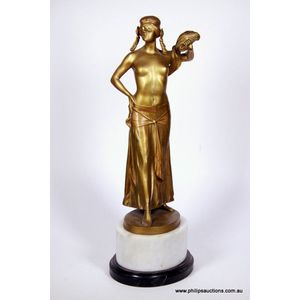Art Nouveau Harpist Figurine "Inspiration"
You must be a subscriber, and be logged in to view price and dealer details.
Subscribe Now to view actual auction price for this item
When you subscribe, you have the option of setting the currency in which to display prices to $Au, $US, $NZ or Stg.
- Art Nouveau Period - The Art Nouveau period was a cultural movement that emerged in the late 19th century, and was characterized by its emphasis on natural forms, flowing lines, and a decorative, ornamental style. Art Nouveau was a reaction against the ornate and heavily stylized designs of the previous era, and sought to create a new, more organic aesthetic.
Art Nouveau was characterized by its use of sinuous, curving lines, as well as a focus on natural elements such as flowers, vines, and other organic shapes. Art Nouveau designers sought to create a total work of art, in which every element of a building or object was designed to be harmonious with the overall design.
Some of the most iconic examples of Art Nouveau design include the Paris Metro entrances designed by Hector Guimard, the works of the artist Alphonse Mucha, and the architecture of Victor Horta in Brussels.
The Art Nouveau period was at its peak between 1890 and 1910, but began to decline in popularity by the start of World War I. However, Art Nouveau remains an important influence on design and art to this day, and continues to be celebrated for its emphasis on natural forms and decorative style. - Spelter - Spelter was the name given to an alloy of zinc and brass or copper used in the 19th century for statuary and lighting. It is a brittle bluish-white metal. It was used as a cheap replacement for bronze, but being brittle easily breaks and can't be repaired. When finished it can often be mistaken for bronze, but if discreet a scratch on the base displays shows a greyish colour, the metal is spelter, if a golden colour the metal is most likely bronze.
This item has been included into following indexes:
Visually similar items

A bronze figurine of 'Salome', circa 1930s. The golden bronzed patinated figure of the semi-clad exotic dancer with the inscribed signature of Leibert to the lower section and raised on a white and black oval shaped base. Height 44.5 cm

Royal Worcester figure of a water carrier painted in burnished gilt tones, on a circular base, impresseed & green printed factory marks, stamped '1810' & dated 1909. Condition good, minor wear to the base. Height 17 cm

A Chinese ivory figure of an elder, Qing Dynasty (1644-1908), Utilising the natural curve of the tusk and simply carved and stained to depict a traditionally attired elder holding a ruyi, with four characters within a double ring underside. Height 25 cm.

A gilt bronze figure of Avalokitesvara, in 18th century style seated with right knee raised in lalitasana on a high double lotus base, her right arm resting on her knee and the left lowered to the base, the head turned slightly to one side with benign expr
